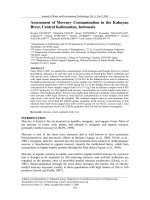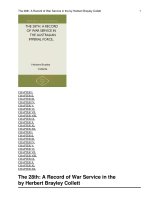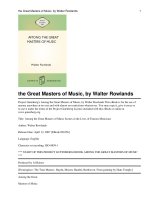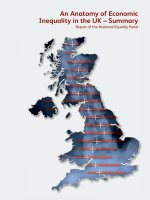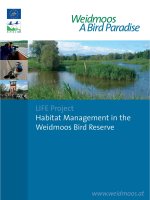Illegal but Common Life of Blast Fishermen in the Spermonde Archipelago, South Sulawesi, Indonesia
Bạn đang xem bản rút gọn của tài liệu. Xem và tải ngay bản đầy đủ của tài liệu tại đây (1.36 MB, 144 trang )
Illegal but Common: Life of Blast Fishermen in the Spermonde Archipelago, South
Sulawesi, Indonesia
A thesis presented to
the faculty of
the Center for International Studies of Ohio University
In partial fulfillment
of the requirements for the degree
Master of Arts
Muhammad Chozin
June 2008
2
This thesis titled
Illegal but Common: Life of Blast Fishermen in the Spermonde Archipelago, South
Sulawesi, Indonesia
by
MUHAMMAD CHOZIN
has been approved for
the Center for International Studies by
Gene Ammarell
Associate Professor of Sociology and Anthropology
Gene Ammarell
Director, Southeast Asian Studies
Drew McDaniel
Interim Director, Center for International Studies
3
ABSTRACT
CHOZIN, MUHAMMAD, M.A., June 2008, Southeast Asian Studies
Illegal but Common: Life of Blast Fishermen in the Spermonde Archipelago, South
Sulawesi, Indonesia (144 pp.)
Director of Thesis: Gene Ammarell
Blast fishing is fishing method practiced by throwing a bomb made from mixed
fuel-ammonium nitrate fertilizer (NH
4
NO
3
) into sea in order to quickly catch large
quantity of fish. However, it is tremendously destructive to coral reefs. It is estimated that
more than 53% of Indonesia’s coral reefs in Indonesia have been threatened by
destructive fishing including blast fishing. Particularly, in the Spermonde Archipelago,
South Sulawesi, more than 75% of fishermen are practicing this fishing method.
My research focus is on technological and socio-cultural aspects of blast
fishermen society in an island within the Spermonde archipelago. Using participant
observation, I looked at the society to observe how deep the practice of blast fishing is
rooted in their cultures, beliefs, and political economy. I also conducted interviews with
fishermen, government officers, and fish traders. By doing so, I tried to understand how
the blast fishermen perceived themselves and others, how they dealt with the power of
the state, and how they responded to the global economy.
Finally, I examined fishermen’s opinions on the sustainability of their maritime
resources including coral reefs and fish stocks. It seems that their awareness of
environmental issues had no impact to their daily life. The desire to achieve economic
gain and modernization overcame their desire for resource sustainability. Even though
4
they knew the negative impact of blast fishing practice in the long run, they continued it
because they are “greedy.” Actually, exposure to the nearby city of Makassar’s modern
life combined with a lack of formal education plunges them into a greediness situation in
which they have only limited alternatives available with which to participate in the
material consumption that surrounds them. The high demand from global markets for fish
attracts them to use short-cuts in fishing. Moreover, the lack of law enforcement
contributes the continuity of this practice.
Approved: _____________________________________________________________
Gene Ammarell
Associate Professor of Sociology and Anthropology
5
The highest dedication is for my both moms:
Muslichatin
and
Dyah Suprobowaty.
You are my inspiration!
6
ACKNOWLEDGMENTS
As I finished this thesis, I would like to acknowledge the people and institutions
which contributed to helping me finish this research. First, I would like to give my
highest gratitude to the Ford Foundation International Fellowship Program (IFP) and
Southeast Asian Studies Program of Ohio University. The Ford Foundation generously
awarded me a scholarship to pursue a master degree at Ohio University; Southeast Asian
Studies kindly awarded me a travel grant to conduct a field research for this thesis in
summer 2007.
Secondly, I would like to thank my academic adviser as well as my thesis chair,
Gene Ammarell, who gave me a lot of academic support and assistance. To all my thesis
committee members: Muhammad Iqbal Djawad from the Marine Center at Hasanuddin
University, Indonesia, who provided me research assistance and advise, and Yeong-Hyun
Kim who patiently read every single paragraph of my thesis and give me feedback.
I will not forget all the people on the islands of Kodingareng, Barang Lompo,
Balobaloang, and Sumanga who were willing to share their underground activities with
me. Without their openness, it would have been impossible for me to write this thesis.
Special thanks to Bukhari, my research assistant, who helped immeasurably in
connecting me to important persons in the blast fishermen society. In addition, I would
also like to thank student activists from HMI-MPO and Inninawa in Makassar who
provided me warm space for discussions. To my colleague, Ridwan Alimuddin, who
offered me preliminary information of blast fishing activities.
7
I extend my thanks to all of my friends at Ohio University who gave me
friendship and warm discussions. From the bottom of my heart, I would like to honor my
“thesis partner”, Lauri Hlavacs, with whom I share many readings and ideas; to Ryoko
for being the best company at the Donkey café while I was writing this thesis, thanks for
translating Japanese references! To my editors: Patricia Black, Molly Roth, and all people
in writing center at Alden library. Special appreciation for Talinn Phillips (the director of
writing center), who did a research on my English writing. Your interviews encouraged
me to keep writing.
Finally, to two others trio-Ford, Farid and Sandra: “We started together, and
finally, graduated together!” Last but not least, to all PERMIAS (Indonesian Student
Association) members whom I cannot mention one-by-one, a thousand thanks for being
the warmest family in Athens.
8
TABLE OF CONTENTS
Page
Abstract 3
Acknowledgments 6
List of Tables 12
List of Figures 13
List of Pictures 14
CHAPTER I: INTRODUCTION 15
CHAPTER 2: COASTAL RESOURCES AS THE COMMONS 20
A. The Idea of Common Property 20
B. Conflicts of the Commons 22
CHAPTER 3: FISHERIES AND COASTAL RESOURCES DEVELOPMENT AND
CONSERVATION IN INDONESIA 28
A. Fisheries Development in Indonesia 28
B. Coral Reef Management 32
C. Destructive Fishing in Indonesia 37
CHAPTER 4: HISTORY OF BLAST FISHING IN INDONESIA 40
A. Blast Fishing Practice in the Colonial Era 40
B. Blast Fishing After Independence 42
C. Contemporary Blast Fishing Practices 43
CHAPTER 5: RESEARCH METHODS AND STUDY AREA 45
A. Research Methods 45
9
B. Research Location 47
a). Spermonde Archipelago 47
b). Kodingareng Lompo 51
CHAPTER 6: BLAST FISHING IN KODINGARENG LOMPO 54
A. Creating an ANFO Bomb 55
a). Ammonium nitrate fertilizer (as munitions powder) 55
b). Kerosene (minyak tanah) 56
c). Detonator (lopis/lucis/dopis) 57
d). Water proof wick (sumbu) 57
e). Weight (laddo) 58
f). Bottle 59
g). Bomb cap (tomba) 59
h). Igniter/lighter (Ju'ju) 60
B. Procedure for Making Bombs 60
B. Fishing Boats 62
a). Perahu (larger motor boat) 62
b). Jolloro’/jolor (mid-size motorized fishing boat) 63
c). Lépa-lépa (small size outrigger boat) 63
D. Operating Blast Fishing 65
a). Preparation on the Main Boat 66
1. Pandega/kep (captain) 67
2. Patula’/pakaca (observer) 68
10
3. Pa'tunu (igniter) 68
4. Pabise (paddler) 69
5. Paguling (helmsman) 69
6. Paselang (diver) 69
7. Bas (machine technician) 70
b). Operating Bombs using the Lépa-lépa 71
E. Encountering Police Patrols 75
F. Fishing Grounds 76
G. Rumpon/rompong (Fish Aggregation Device/FAD) 76
H. Fishing Time 78
I. Blast Fishing Risks 79
J. Fish Captured 81
CHAPTER 7: SOCIETY OF THE BLAST FISHERMEN COMMUNITY 83
A. Patron-client Relationship in the Blast Fishermen Groups 83
a). Case: Life a Young Juragang 87
b). Case: Life of a Sawi 90
B. The Religious and Cultural Values 93
Pilgrimage to Mecca (haji) 98
C. The Role of Women 101
D. Blast Fishermen Relationship with other Fishermen 103
a). Blast Fishermen and Line Fishermen 103
b. Blast Fishermen and Cyanide Fishermen 104
11
CHAPTER 9: BLAST FISHERMEN ECONOMY AND NETWORKING 107
A. Fishing Revenue and Cost 108
a). Profit Share 110
b). Cost of Making Bombs 114
B. Networking and Marketing System 115
a). Juragang (boss) 116
b). Pabalolang (fish broker) 117
c). Fish Industries 118
d). Fish Traders 120
e). Exporters 120
f). Bomb Materials Suppliers 120
CHAPTER 9: DISCUSSION AND CONCLUSION 123
A. Discussion 123
a). Patron-Client Relations 123
b). Islands-Mainland as a form of a Rural-Urban Relationship 126
c). Ideas of Conservation 129
B. Conclusion 130
References 133
Appendix A: List of Fish Captured by Blast Fishing 140
Appendix B: List of interviews 144
12
LIST OF TABLES
Page
Table 1: Some Conflicts between Fishermen in Indonesia in Year 2000-2002 26
Table 2: The Contribution of Marine Resources to GDP among Asian Countries 29
Table 3: Characteristics of Blast Fishermen in the Spermonde Archipelago 65
13
LIST OF FIGURES
Page
Figure 1: Map of the Spermonde Archipelago. 48
Figure 2: Map of borders of the Spermonde Achipelago 49
Figure 3: Procedure to make a bomb 61
Figure 4: Position of bombers on the lépa-lépa 74
Figure 5: Two different models of fish aggregation device (FAD) 77
Figure 6: Curve of the economy of blast fishing in twenty years 108
Figure 7: Revenue distribution within blast a fishermen group 113
Figure 8: Blast fishermen networks 122
14
LIST OF PICTURES
Page
Picture 1: Kodingareng Lompo Island 51
Picture 2: An example of ANFO bomb 54
Picture 3: Ammonium Nitrate fertilizer 55
Picture 4: Kerosene 56
Picture 5: A bunch of detonators and wicks 57
Picture 6: Drinking bottle 59
Picture 7: Igniter (juju’) 60
Picture 8: Perahu (large motor boat) 62
Picture 9: Jolloro’/jolor (mid-size motorized fishing boat) 63
Picture 10: lépa-lépa (small-size outrigger boat) 64
Picture 11: Divers use compressor to breath underwater when they dive 70
Picture 12: Bomber crews assessing fish and ready for blasting 72
Picture 13: A Haji with his white hat (songkok) 100
15
CHAPTER I: INTRODUCTION
Blast fishing is a fishing method using a bomb to capture a school of fish. The
bomb material is made from dynamite, ammonium nitrate, or any kind of explosives.
However, most fishermen use modified bomb made from fertilizer contains ammonium
nitrate mixed with kerosene. It is a very efficient fishing method to catch the huge
amount of fish at the quick time with less cost and less work. However, its is destructive
to the environment because the side impact of blasting damages the coral reefs and kills
untargeted fish.
Many scholars have studied blast fishing method, particularly in the Spermonde
Archipelago and areas surrounding from different points of view. The recent study by
Destructive Fishing Watch (DFW 2003) describes the general idea of the blast fishing
practice from technical to social aspects. This study also briefly covers the environmental
destruction caused by blast fishing activities, in particular, to the coral reefs. Other
studies examines the environmental damages were by Briggs (2003) and Noveria, et. al.
(2007). Moreover, Pet-Soede and Erdmann (1998) studied its economic aspect, Ansary
(2002) look at its legal aspect, and Meereboer (1998), Alimuddin (2004), and Hamamoto
(2007) did an anthropological study of a blast fishermen society. Finally, the
development strategies of the society in regard to conserve the environment on the area
threatened by blast fishing was done by Alder and Christanty (1998), Amri (2002), and
Hidayati (2003).
Blast fishing is practiced by throwing a bomb into water in order to catch fish.
Usually, the bomb material is made from ammonium nitrate fertilizer (NH
4
NO
3
) and fuel
16
oil, called ANFO (Ammonium Nitrate-Fuel Oil) (Ansary 2002, p 35). Fishermen then
mix the bomb material with kerosene in the bottle and ignite it by using waterproof fuses.
A simpler bomb is created by placing matches in a bottle connected outside by a small
wick. Fishermen will explode the ‘bottle bomb’ once they have gotten close to the school
of fish by lightning the wick and then throwing it directly into the school. The impact of
this kind of bomb is little, detonating only 2-3 meters below the surface of water, doing
little damage to the reef. With a more powerful bomb, one bottle bomb may affect about
10-20 meters square. However, the most powerful level bomb use materials including
TNT (Tri-Nitro-Toluene) produced by the army. TNT or dynamite bombs cause massive
damage to coral reefs.
Blast fishing is an unsustainable fishing practice since it causes environmental
problems in the long run. The practice of blast fishing not only kills schools of fish but
also kills coral reefs surrounding the detonation site. The massive destruction of coral
reefs damaged by bombs in Indonesia had been reported by Briggs (2003). He estimates
that more than 53% of Indonesia’s coral reefs are threatened by destructive fishing
including fish bombing. Citing from Chou (2000) and WIC (2002), Briggs also estimates
that the regular blast fishing in one area will destroy approximately 50-80% of the coral
reef surrounding it.
In South Sulawesi, especially in the District of Pangkajene Kepulauan, the main
cause of the depletion of fish products is coral reefs destruction. When the coral reefs are
damaged, the fish lose their food and habitat. Therefore, the unsustainable fishing
practices like blast fishing, cyanide (poison) fishing, and trawling have a tremendous
17
impact to fish stocks (Noveria, et. al., 2007). In 1998, Pet-Soede and Erdmann (1998)
estimates that up to 15% of the fishermen in some villages fishing the Spermonde
archipelago in South Sulawesi are blast fishermen, with their catches supplying 10-40%
of the total landings for the 16,000 km
2
fishery.
Sievert (1999) concluded that blast fishing is not only practiced by impoverished
fishermen, but also higher economic classes. They are practicing blast fishing with
support from businessmen, political leaders and also police and military officers.
Fishermen try to catch as much as they can as fast as they can, because they do not know
how long fishing will remain profitable. Through blast fishing, fishermen got more fish
than by other conventional fishing methods. By using bombs for fishing, they reduced the
cost required for fishing, reduced the amount of work, and reduced the number of fishing
trips. However, it increased the number of fish they caught. With the US$1-2 cost of
building a bomb, it may give them a catch when market value is US$14-40 (Briggs,
2003). That is why, even though it is illegal, many fishermen keep practicing this method.
However, in the long run, the practice of blast fishing potentially creates conflicts
among fishermen. The excessiveness of blast fishing in exploiting the common property
of ocean’s resources directs the societies to have “conflict of the commons” (Hardin
1968). Hardin’s analogy of “conflict of the commons” among grazers in taking advantage
of limited resources on land is appropriately parallel to the conflicts among fishermen in
taking advantage of ocean’s resources. In fact, there have been some conflicts between
blast fishermen and non-blast fishermen in the Spermonde archipelago recorded in
Ansary (2002) and DFW (2003).
18
My research is based on field work within a blast fishing community who on an
island in the Spermonde archipelago, South Sulawesi, Indonesia. Doing two month field
research in South Sulawesi, Indonesia, I studied the strange life of destructive fishermen.
I interviewed fishermen, fish businessmen, and government officers. Moreover, I joined
their daily life and fishing activities to portray their secret networks.
Primarily, I focus my study on the technological and socio-cultural aspects of the
society where blast fishing practice is common. By using “participant observation”, I
wanted to learn about their cultures and customs. As part of South Sulawesi, the
Spermonde archipelago has long been inhabited by maritime cultures in Indonesia:
Makassar, Bugis, and Mandar. I wanted to more closely examine the islanders’ particular
culture in contrast to the urban culture on the mainland where there are greater influences
from other non-local cultures. Finally, I analyzed how deeply the blast fishing practice is
rooted in the culture.
Second, I looked into religious values including their interpretation by local
religious leaders was conducted. Since almost all people living there are Muslim,
studying how people interpret Islamic teachings connected to environmental issues is
important. Therefore, studying local religious leaders’ behavior and their role in the
society is very useful to understand religious influences in the society. Since in many
societies, local religious leaders are somehow separated from local cultural and political
leaders, to study how people associate themselves with both types of leaders is very
helpful in describing the role of religious and cultural values in the society.
19
Finally, even though economic studies of blast fishing had been conducted by
scholars like Pet-Soede, C., H.S.J. Cesar, and J.S. (1999) and by Tropical Research and
Conservation Center (TRACC) (2001) in Malaysia, I studied an aspect of economy of
blast fishermen by reviewing their daily catches. Although it is an illegal practice, many
fishermen are still engaged in blast fishing. In addition, it is interesting to study how
government officials selectively enforce the state law among fishermen. In Indonesia,
blast fishing is prohibited by Indonesian Government Regulation Number 9/1985,
Regulation Number 10/2001, and Regulation Number 359/40/DKP/2001. Therefore, I
also examine local authorities’ role in regard to the blast fishermen society.
In particular, I raised the following questions: Why do people practice blast
fishing? What percentage of the fishermen in the village are blasting fish? What are their
perceptions of religious values and culture? How do villagers relate their religious values
and cultures to fishing practices and conservation of marine resources? How deeply are
they aware that blast fishing is illegal? What do they think of fishermen who are not blast
fishing? What do people think of blast fishermen? How does the social system inform the
practice of blast fishing? What is their connection with local and global markets and
capital? Do they feel their life has improved? What do they think about government
officials and policies?
20
CHAPTER 2: COASTAL RESOURCES AS THE COMMONS
A. The Idea of Common Property
The idea of common property was discussed by Garet Hardin forty years ago in
an influential theory regarding natural resource management. In his article “The Tragedy
of Commons,” Hardin (1968) introduced the concept of “the commons,” where people
tend to exploit natural resources excessively due to their desire to fulfill their personal
interests. As Hardin defines it, “A commons could be any resource pool open to many but
lacking in substantial governing rules.” He gave a brilliant example of how farmers tend
compete on using the common property of a field of grass to feed their cattle. As one
farmer grazes more to raise cattle productivity, other farmers will follow him to graze
more without considering the sustainability of the grass field. On a broader scale, this
concept can be extended to the largest commons: the natural resources of the ocean. It is
commonly understood that the world’s oceans are considered as common property where
individuals and corporation exploit the resources for personal gain.
The concept of the ocean as common property was introduced long time before
Hardin. In 1609, Hugo de Groot (Grotius) proposed the concept of mare liberum (the
freedom of ocean). He proposed that concept as a response to conflicts between the
Dutch and Portuguese in the colonial territory of the Malaka Strait when the Dutch
burned Portuguese ships whenever their ships went through the strait. The Dutch claimed
that the Malaka Strait was their territory, so they had the right to use it. On the other
hand, the Portuguese argued that they had the right to pass through the strait base upon
21
the Tordesillas
1
agreement between Portuguese and Spain. Therefore, according to
Grotius, every nation has a right to take advantage of the sea to support their daily life
through navigation, fishing, research, and other pursuits. His concept was based on the
assumption that the oceanic resources are abundant and impossible to deplete.
Interestingly, this is remained a common belief among many fishermen, including among
blast fishermen.
People like to settle on coastal areas and take advantage of the ocean, at least
three reasons. First, coastal areas often are productive ecosystems that can support human
life. The resources such as fish, mangrove, estuaries, and coral reefs support the human
life. Second, coastal areas provide resources for industries, housing, energy,
transportation, waste disposal, and other needs. Third, the beauty of the ocean attracts
people make it as a tourist destination (Bengen dan Rizal 2001). The longtime
exploitation of the ocean’s natural resources has resulted in their depletion. Increasingly,
people have come to realize that the ocean limited in its ability to support human life.
Therefore, they have started to manage the ocean’s natural resources.
In Southeast Asia, the history of managing the ocean’s natural resources was
started long ago. The concept of sea tenure systems, where groups of people manage their
sea area by themselves was traditionally practiced. Using customary law (adat), they
regulated themselves including the regulation of fishing grounds, fishing methods, and
fishing seasons. One group often had an unwritten agreement with another group
regarding those fishing grounds, fishing methods, and fishing seasons. For example,
1
The Treaty of Tordesillas divided the newly discovered lands outside Europe into an exclusive duopoly
between the Spanish and the Portuguese along a north-south meridian 370 leagues west of the Cape Verde
islands signed at Tordesillas, Spain on. June 7, 1494 (Davenport 1917).
22
fishermen in villages in Southern Thailand who had common fishing grounds had a
common agreement over fishing their fishing areas. They had an agreement of non-
fishing areas within the inside edge of coral reefs and the outsider edge of coral reefs,
which is deeper water, as a free area for fishing (Ruohomaki 1999, p 120-122). People in
North Sulawesi also continue to have sasi laut which are traditional regulations to
conserve natural resources and regulate of fishing methods (Bayley and Zerner 1992;
Harkes 1999). Therefore, these traditional systems of sea tenure suggest that what might
be seen as an unregulated commons is a community property where a fishing community
manages it’s sustainably for the benefit of all.
B. Conflicts of the Commons
However, the modernization of fishing life tends to ruin those traditional customs.
The mechanization of fishing methods followed by the market demand encourages
fishermen to exploit the ocean natural resources excessively and ignore those traditional
customs. The application of engine and modern fishing tools give them the possibility to
capture fish as much as they want in order to fulfill the market demands. Their interaction
with global markets creates “new needs,” to consume products of world’s markets,
plunging them into greediness. Sometimes, due to competition over the ocean’s natural
resources, this greediness creates conflicts. Often, the conflicts occur because of the
disparity in applying fishing technologies. When groups apply advance fishing
technology while others cannot, there is a potential for conflict. That happened in 1980s
when a new technology for large scale fishing (trawling) was introduced. The conflicts
occurred between traditional fishermen and trawlers because the trawl fishing
23
marginalized small-scale fishing. Using big scale of fishing, trawl fishermen ruined the
small-scale fishermen’s fishing ground (Bailey, 1988). The conflict was started even
earlier, with the introduction of the outboard motor for fishing in the 1960s. There were
conflicts between traditional fishermen and motorized fishermen because traditional
fishermen cannot compete with motorized fishermen in fishing (Semedi, 2003;
Ruohomaki, 1999).
According to Kendrick (1993), other factors that cause conflicts are the depletion
of the resources, the rapid growth of population, migration, and government policies.
When fishermen are always trying to increase their catch, they may not care about
conserving the resources for the next generation. The responsibility of taking care of their
family requires them to work as hard as they can. There is no chance to think about
conservation and maintaining the resources for future generations. The hard work to
catch fish is seen as an effort to increase the well being of next generation, their children.
If they can feed and educated their children well, they ensure a better future for their
family and themselves. Moreover, migration often places pressure on the local habitants.
If the local people are concerned about conserving the natural resources, people from
outside often do not care about conservation. Their lack of local knowledge and their
distance from local values mean they do not have sense of belonging with the local
natural resources. They tend to exploit the resources for their benefit rather than thinking
about the common benefit of the natural resources. The conflict between Bajo and Bugis
in Taka Bonerate atoll in South Sulawesi is an example. The Bugis, who arrived on the
island after the Bajo, are concerned more about prosperity rather than the environment.
24
Therefore, they are economically better off than the Bajo who concern themselves with
maintaining the environment (Alder and Christanty 1998; Reichel 2006).
Finally, government policy also plays a role in creating conflicts. The idea of
privatization, as it is proposed by some scholars (Hardin 1968; Ophuls 1973), to protect
the common property became a disaster when it was implemented by the Indonesian
government in the case of shrimp farming. Shrimp farming accounts for the biggest
portion of fish farming activities in Indonesia. It accounts for 56 percent of the total
export of fish products. The products are exported to Japan (50.75 percent) and USA
(14.49 percent), Thailand (7.97 percent), China (5.13 percent), Singapore (2.68 percent),
and Hong Kong (2.67 percent) (DKP 2004). However, big companies, especially from
Thailand (Charoen Phokphan) and France own most of the shrimp farms. Therefore,
shrimp farming provide less economic benefit for poor people in coastal areas. Local
communities are marginalized and exploited by large-scale fish farms, and this often
results in conflict. In November 1998, about 1,600 small farmers protested against the
conditions imposed by the big fish farming company (Siregar, 2001). The change from
traditional to industrial shrimp farming benefitted the government and the large-scale
shrimp investors due to foreign currency generation in the short run. However, the
environmental and social costs associated with the industry are more costly in the long
run.
Shrimp farming also devastates the country’s mangrove ecosystems that were
logged or converted to shrimp and other fish ponds over the past two decades. Indonesia
is home to one of the world’s largest and most diverse mangrove forests. The massive
25
areas of mangrove and peat swamp forests have been rapidly and unsustainably exploited
for shrimp farming. As an example, mangrove logging in Lampung Province (southeast
coast of the Sumatra Island) damaged 736,000 hectares of mangrove forest (Shrimp
News International, June 1, 2007).
Intensive shrimp farms, while reducing the
mangroves, also have another problem. Their nutrient-rich effluents discharged into the
environment seriously harm the ecological balance. The waste contains chemical
fertilizers, pesticides, and antibiotics that pollute the environment.
Recently, there are many new conflicts among fishermen under regulation no.
25/1999 of Regional Autonomy (Otonomi Daerah). In the years after 2001, when the
regulation no. 25/1999 was implemented, media reported many conflicts among
fishermen especially in the island of Sumatera and Java. Adhuri (2002) summarized some
of those conflicts.
